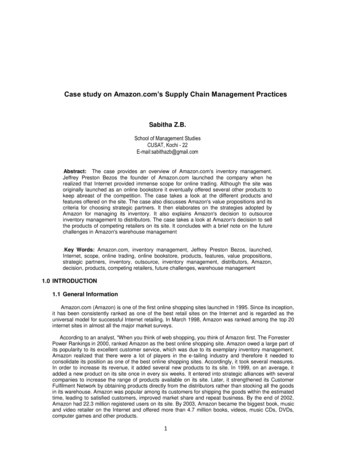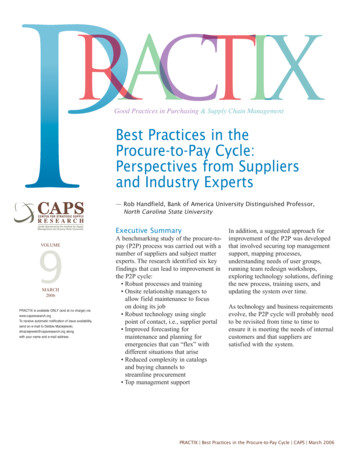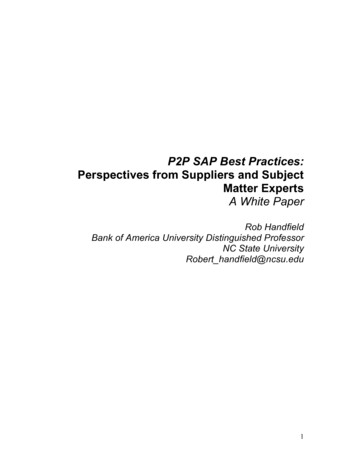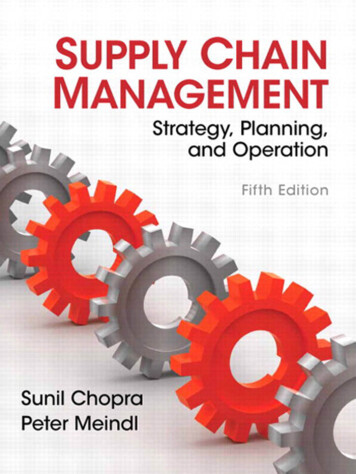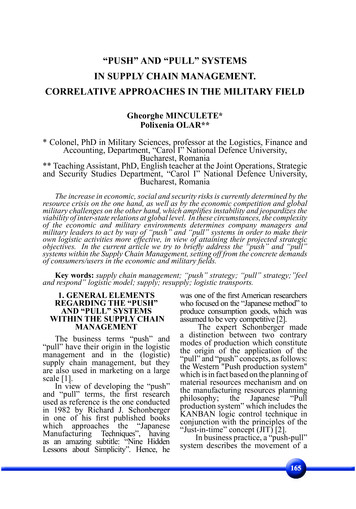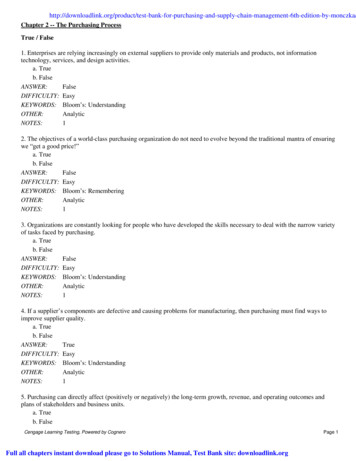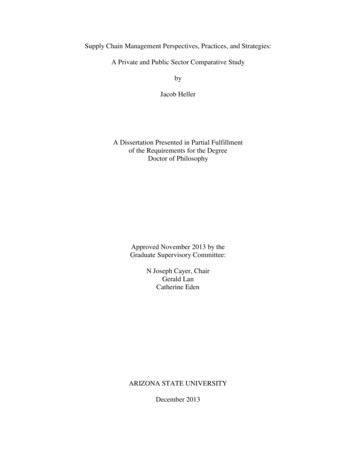
Transcription
Supply Chain Management Perspectives, Practices, and Strategies:A Private and Public Sector Comparative StudybyJacob HellerA Dissertation Presented in Partial Fulfillmentof the Requirements for the DegreeDoctor of PhilosophyApproved November 2013 by theGraduate Supervisory Committee:N Joseph Cayer, ChairGerald LanCatherine EdenARIZONA STATE UNIVERSITYDecember 2013
ABSTRACTThis dissertation is an exploratory study that examined the differences inperceptions about supply chain management strategy, topics, tools, and techniquesbetween procurement professionals in public and private sector organizations. This wasaccomplished through a survey of procurement professionals in a Fortune 500 companyand a municipality in Arizona. The data were analyzed to understand how perceptions ofsupply chain management differed within this sample and whether the differences inperceptions were associated with formal education levels. Key findings indicate that forthis or similar samples, public procurement respondents viewed their organizations’approach to supply chain management as a narrow function within purchasing whileprivate sector respondents viewed their organization’s approach to supply chainmanagement as a strategic purchasing perspective that requires the coordination of crossfunctional areas. Second, public procurement respondents reported consistent andstatistically significant lower levels of formal education than private sector respondents.Third, the supply chain management topics, tools, and techniques seem to be moreimportant to private sector respondents than the public sector respondents. Finally,Respondents in both sectors recognize the importance of ethics and ethical behavior as anessential part of supply chain management.i
DEDICATIONFor my beautiful wife Carley and my five wonderful children, Denton, Tyler,Cason, Cooper, and Katy.ii
ACKNOWLEDGMENTSBut for the loving support of so many, this project would not have been possible.To Carley, my best friend and our family’s foundation, thank you for your unconditionallove, support, and determination. Your willingness to tend to the many familyresponsibilities during my doctoral program kept us all together. To my loving parents,Vic and Andrea, thank you for the unceasing love and encouragement throughout mydoctoral program.With gratitude, I wish to thank my Committee Chair, Dr. N. Joe Cayer, for hisguidance, encouragement, and support throughout the dissertation process. Without him,I am certain that this would not have been possible. Finally, I wish to thank mycommittee members, Dr. Gerald Lan, Dr. Martin Vanacour, and Dr. Catherine Eden, eachof whom has played an important role in the completion of this dissertation andultimately, in my success.iii
TABLE OF CONTENTSPageLIST OF TABLES .viLIST OF FIGURES . viiCHAPTER1INTRODUCTION . . 1Understanding Supply Chain Management . 3Research Questions . 7Study Significance . 82LITERTURE REVIEW . 11Strategy . 11Supply Chain Management. 15Supply Chain Management and Public Procurement . 23Supply Chain Management and the Private Sector. 28Supply Chain Management Topics, Tools, and Techniques . 29Supply Chain Management Perceptions . 403METHODS . . 42Measurement . 42Study Design . 43Participants . 44Data Collection Instrument . 45Statistical Analyses . 50iv
CHAPTERPageLimitations. 514RESULTS . . 52Characteristics of Participants . 53Comparison of Perception . 555CONCLUSION . . 74Key Findings and Implications . 74Study Significance . 82Future Research . 83Conclusion . 85REFERENCES. . 91APPENDIXAINDEPENDENT SAMPLE T-TESTS: PUBLIC VS. PRIVATE SECTORS . 92BSUPPLY CHAIN MANAGEMENT SURVEY . 94v
LIST OF TABLESTablePage1.Participant Years of Purchasing or Supply Chain Management . 542.Participant Formal Educatoin and Perception of Job Scope . 553.Apporach to Supply Chain Management by Sector . 584.Scope of Daily Work by Sector . 595.Formal Education by Sector . 626.Job Scope by Degree . 647.Top Ten Lists of Supply Chain Management Tops, Tools, and Techniques . 658.Statistically Significant T-test Results for Supply Chain Management. 669.Non-significant Results for Topics, Tools, and Techniques . 68vi
LIST OF FIGURESFigurePage1.Purchasing vs. SCM Perspectives . 482.Importance Scale for SCM Topics, Tools, and Techniques . 493.Box Plots for Significant Topics, Tools, and Techniques . 673.Box Plots for Ethics Related Topics, Tools, and Techniques . 69vii
CHAPTER 1INTRODUCTIONThis dissertation examined the differences in perceptions about supply chainmanagement strategy, topics, tools, and techniques between procurement professionals inpublic and private sector organizations. This was accomplished through a survey ofprocurement professionals in a Fortune 500 company and a municipality in Arizona. Thedata were analyzed to understand how perceptions of supply chain management differedand whether the differences in perceptions were associated with formal education levels.In today's global economy of competition in private organizations and ever-shrinkingbudgets in public organizations, procurement strategy is becoming increasinglyimportant. Financial activities of public organizations are estimated to be as great as 1030% of the GNP in the US and as much as 14-20% of the GDP in Europe with goods andservice costs accounting for more than 60% of the total costs (Callendar & Matthews,2000; Degrave, Roodhooft & van Doveren, 2005; Mori & Doni, 2010). Consequently, theselection and successful implementation of sourcing strategy can lead to, among otherthings, reduced budgetary pressure, increased value for money, significant cost savings,and the overall more effective management of public funds.Strategy is defined as a course of decisions made by organizations that create andreveal core objectives, purposes, and goals. For purposes of this study, strategy is definedas the creation of a unique and valuable position, involving a different set of activities(Porter, 1996). It is a theory of business based on four basic functions. First, it charts acourse of action for the organization through the environment. Strategy promotescoordination and alignment within the organization. Effective strategy provides1
mechanisms for people to differentiate the organization and it reduces ambiguity andprovides order (Mintzerg, Ahlstrand, and Lample, 2005). Further, an organization’sstrategy guides the creation of the policies and plans for achieving those goals andenables the definition of the organization’s scope and business pursuits (Andrews, 1971).Strategy determines how organizations engage in and interact with the globalmarket. Optimally, strategy coordinates resources that yield a core and distinctcompetence, differentiation and ultimately, a competitive advantage. The effect ofsuccessful sourcing strategy is a clear framework to coordinate procurement activityresulting in maximum savings for public organizations yielding greater efficiency andeffectiveness in procurement activities.Strategy is required for public organizations to be successful. Supply chainmanagement (SCM) began as a sourcing strategy but quickly gained prominence in theacademic literature and in practice and has grown into a business discipline similar tomanagement, marketing, or operations. In fact, supply chain management has becomesuch a popular discipline that it is difficult to pick up a manufacturing, distribution,marketing, customer management or transportation periodical without finding an articleabout supply chain management or supply chain management related topics (Ross, 1998).Supply chain management represents a significant shift in the way that organizationsfunction, including changes in the integration and coordination of supply, demand, andrelationships in order to satisfy customers in an effective and profitable manner both inprivate and public organizations.Forester (1958) described a basic tenet of supply chain management decadesbefore it came to prominence as a field of study and practice. To him, management was2
on the verge of a major breakthrough in understanding how industrial company successdepends on the interactions among the flows of information, materials, money,manpower, and capital equipment. The way these five flow systems interlock to amplifyone another and to cause change and fluctuation will form the basis for anticipating theeffects of decisions, policies, public organizational forms, and investment choices.(Forrester 1958, p. 37).Forrester’s theory of distribution management preceded supply chain managementin that he recognized the need for interwoven organizational relationships across businessfunctions. Forrester (1958) predicted, “there will come general recognition of theadvantage enjoyed by the pioneering management who have been the first to improvetheir understanding of the interrelationships between separate company functions andbetween the company and its markets, its industry, and the national economy” (p. 52).Forty years before its inception, Forrester’s theory identified key management issues andillustrated the dynamics of factors associated with the phenomenon that would eventuallybe referred to in business literature as supply chain management (Mentzer et al., 2001).Understanding Supply Chain ManagementPrivate sector purchasing strategy has been redefined as supply chainmanagement, a competitive strategy for integrating suppliers and customers with theobjective of improving responsiveness and flexibility of private organizations(Gunasekaran, 2004; McCue and Pitzer, 2005). For purposes of this paper, the vision ofthe Supply Chain Management function, in public and private organizations, is toefficiently manage the forecast, procurement and delivery of goods and services through3
the supply chain in a cost effective manner. Supply chain management has become aneffective source of competitive advantage for private sector organizations. Ironically,supply chain management is grounded on a paradigm of strategic management thatemphasizes the development of collaborative relationships to gain competitive advantage(Dyer, 2000). Collaboration enables combination of perspectives, skills, and resourcesbetween public organizations to enhance strategic differentiation and competitiveadvantage (Lasker, Weiss & Miller, 2001). Though collaborations may differ in structureor form, scope or objective, or in partnership, they all share a common motivation; theappreciation that in today’s environment many objectives related to SCM collaborationare not attainable without a collaborative strategy (Lasker, Weiss & Miller, 2001;Zuckerman, Kaluzny & Ricketts, 1995).In the private sector, supply chain management drives improved performance bymaximizing internal and external capabilities to create a seamlessly coordinated supplychain. Within the collaborative paradigm the performance of all members in the supplychain contribute to the overall success or failure of the entire supply chain. The supplychain management network of interdependent relationships is built through strategiccollaboration with the goal of mutual benefits (Ahuja, 2000).Though a salient governmental function, procurement has been a neglected areaof academic research (Thai, 2001). It is through procurement that federal, state, county,and local governments undertake public works, build roads, and provide healthcare,education, and public order and safety (Erridge & McIlroy, 2002). In the public sector,procurement is also utilized as an important tool for achieving economic, political, social,and other objectives (Arrowsmith, 1998). Included are provisions of no or low cost public4
goods and services, the development of local contractors and manufacturers by allowinglocal buyers to build in a margin of preference for local contractors and manufacturers,and advance legislation and conceptions of social justice through market regulation.Finally, public sector procurement serves a broader range of stakeholders, places greateremphasis on accountability and transparency, and allows little or no flexibility fornegotiation.The effect of the layers of additional scope and limited ability to negotiate is thecreation of procurement inefficiencies. These inefficiencies often lead to increasedspending through increased administrative demands through additional oversight,decentralization of work across multiple suppliers, and time delays given legislative andlegal requirements. All of which result in the inefficient delivery of goods and services.Though supply chain management has not been widely incorporated in the public sector,an opportunity exists for public sector organizations to do so as the core supply chainmanagement objective, to effectively and efficiently manage the acquisition of material,the production and distribution of goods or services to customers (or citizens), is the sameacross sectors. However, consideration must be given to the varying environmental andcontextual differences in the public sector before attempting to implement supply chainmanagement strategies in the public sector.The performance of public organization procurement activities represents asignificant part of an historical procurement challenge confronting American publicadministrators - balancing the demands of effectiveness and equality. Publicadministrators must balance the achievement of social goals and the need for fiscalefficiency. Pressures on politicians and public administrators for increased efficiency in5
the use of public resources and accomplishment of social goals have mounted in recentyears, and increasing spending from tax revenue drives this concern. Tax payers expectpublic administrators to provide ‘a bigger bang for the buck,’ and to enable more efficientspending to provide more with less.A great potential exists for the public sector in the form of supply chainmanagement and the leveraging, combining, and capitalizing on complementary strengthsand capabilities in procurement activities (Alter & Hage, 1993; Zuckerman, Kaluzny &Ricketts, 1995). A number of authors have examined private sector application of supplychain management for application in the public sector (Johnson, Leenders, & McCue,2003; Murray, 2007; Thai, 2001). They found that the job skill sets and functions ofpurchasing professionals, specifically job duties and skill sets attributes pointed to moreprofessionalism and broader business skills for purchasing agents in privateorganizations. Additionally, they found that implementation of supply chain managementin the public sector would be challenging given differences in their fundamental goalsand practices (Harland, Gibbs and Sutton, 2000; Johnson, Leenders and Fearon, 1998a;Johnson, Leenders, and Fearon, 1998b; Leenders and Johnson, 2000; McCue and Pitzer,2005; Telgen, Zomer and de Boer, 1997).Larson (2009) noted that these fundamental differences exist in reportingstructure, regulating bodies, funding sources and operating motives. Public organizations’professional activities are governed by elected executives, legislative bodies, laws, anduntold numbers of state and federal regulations. Private organization professionals areguided by boards of directors, managers, business plans and purchasing policies. Fundingsources in public organizations carry with them innate implications regarding their use.6
They draw revenue from taxes and fees that must be audited and spending decisions mustbe transparent. Thus, these funds must be used for the public good - to serve the public.Private organizations generate revenue through the sale of goods and procurementsuccess is measured by cost savings and/or profits. They face no external requirementswhen assessing how procurement funds are used. Professionals in public organizationsmust consider the aspects of procurement, discussed earlier, which are beyond profit. Thescope of SCM is broader than simply procuring required goods and services by the mostcost efficient means. SCM Collaborative Strategy Model incorporates a number of othergoals, such as the development of its local economy and small business therein, jobcreation, promotion of open equitable markets, and strict adherence to clear procedures,fair competition, and transparency (Telgen, Zomer & de Boer, 1997).Notwithstanding the great potential that private sector strategy and practices holdfor public procurement, a careful analysis of the differences between public and privatesector procurement is essential before implementation (Reed, Bowman & Knipper,2005). Consequently, the purpose of this research is to compare how practitioners inprivate and public sector view supply chain management strategy, topics, tools andtechniques and the factors that influence them in private and public sector purchasingorganizations.Research QuestionsThe general aim of this research is to assess the fundamental differences that existin perceptions of supply chain management strategy, topics, tools, and techniques7
between procurement professionals in the public and private sectors.
management, marketing, or operations. In fact, supply chain management has become such a popular discipline that it is difficult to pick up a manufacturing, distribution, marketing, customer management or transportation periodical without finding an article about supply chain managemen


